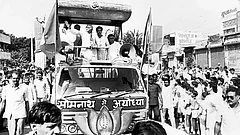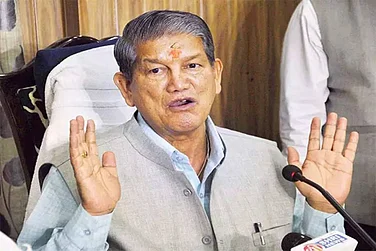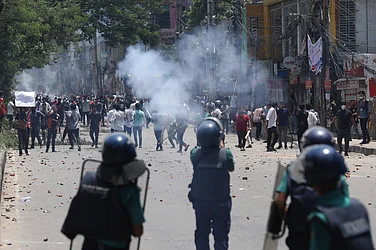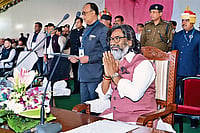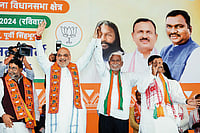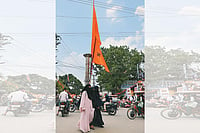“He has a voice like the sound of a dundubhi (kettledrum). He has shining skin. He is full of splendour. He is square-built. His limbs are built symmetrically. He is endowed with a dark complexion.”
In Sundara Kanda of Valmiki Ramayan, when Sita asks Hanuman to prove that he knows Ram and Lakshman, this is his response. The repetitive reference of Ram’s dark skin has come up several times across different Ramayanas. But the scriptures do not always represent the practiced reality. In a world of multiplicities, where the contest between the great and little traditions continues unabated, Ram sometimes is depicted in blue; sometimes in black; and, on a few occasions, even in white or green.
So, what is the skin colour of Ram? Can there be any unanimity? In a country that is populated by what the West calls ‘brown’ people, colour matters. And when it comes to the most politically active god of the century—who himself fought a court case to ensure his rights over his birthplace—the debate over the depiction can have broader political meanings.
The debate began when three renowned sculptors from different parts of the country were invited to make the 51-inch tall idol of five-year-old Ram lalla to be installed in the sanctum sanctorum of the Ram Mandir. While two of them—Ganesh Bhatt and Arun Yogiraj—carved the idol out of bluish-grey stone known as Shyam-Shila, which was brought from Karnataka, Satyanarayan Pandey made a white idol, carving it out from the makrana marble of Rajasthan.
On January 1, Prahlad Joshi, the Union Minister of Parliamentary Affairs, in a tweet, declared that the idol made by Yogiraj would be installed in the consecration ceremony. Newspaper reports, however, pointed out that though 11 of the trust members supported Yogiraj’s idol, a few senior members favoured Pandey’s ‘Shweta’ version during their meeting on December 22. Is the colour of the idol important in terms of contemporary politics? Hindu saints and scholars think that different interpretations lead to different perceptions and hence, multiple colours.
Black, Blue, White, Green...
However, this is not the first time that Ram was portrayed as white. In different television depictions, including the most popular one by Ramanand Sagar, Ram is anything but dark. Even when portrayed otherwise, he is shown in blue.
Mythologist and author Devdutt Pattanaik, while pointing out the preference of blue over black, writes, “We had gods who were always pink, demons who were always brown and dark gods who were always blue. Indra, Brahma and Durga were pink, Asuras and Rakshasas were brown. Vishnu, Ram and Krishna were blue. Somehow, an unnaturally blue Krishna was preferred over a naturally dark Krishna. ‘Because blue is the colour of the sky, of ether, of divinity,’ we were told.”
Talking about the blue depiction of Ram, Deepam Chatterjee, the author of The Millennial Yogi, says, “Blue depicts the infinite. It is the colour of the clear day sky, and of the deep sea. Divinity is often depicted as infinity. Hence, depictions of Lord Rama as blue are symbolic of his divine nature.”
With reference to the Bhakti literature tradition of the Ramayana, Chatterjee notes that Ram is called “Nīlameghashyama”—the one who is of the complexion of a blue-black cloud. In Goswami Tulsidas’s description: “Whose body has the hue of a blue lotus, who is dark-skinned, whose body parts are soft, on whose left resides Sita...” So, the depiction of Ram in goura (pale red, white, yellow) varna can be considered as an “artistic imagination”, he adds.
The debate, nonetheless, intensified a few months ago as an AI-created image of a white and fair Ram went viral, and people from different professions came down heavily on social media for ‘whitewashing’ their god. Devi Neha Saraswat, a popular bhajan singer, in her Instagram post, writes, “Either the AI is racist, or the people who fed the information are racists. Ram never has such a skin complexion. He was dark with a raincloud complexion. I never thought God having an African skin complexion will be seen in a dislike mode!”
Chetan Rajhans, the national spokesperson of Sanatan Sanstha, says, “In our Hindu tradition, statues are made of either metals or stones. Though the statues shouldn’t be compared to each other, the Shyam-Shila is considered holier.” The Balkhand of Tulsidas’ Ramayan also refers to Ram as ‘Tanu, ghana, shyama’ and thus his skin colour has been chosen as black, he adds.
An Indication to Dalits, Adivasis and South India
In popular narratives of the Aryan invasion theory, Ram is considered to be the white god of the north, whereas Shiva is the black god of the south. But scholars like Pattanaik don’t subscribe to such ideas. Referring to Shiva’s description as Karpura-Goranga—who is as fair as camphor—he writes, “Some say that Vishnu and Ram are gods of the Aryan imperialists—but both are described as dark. This theory of Aryan invasion, with roots in 19th century racial theory, seems too simplistic.”
However, there are scattered political opinions that say the BJP is trying to address the Dalit and Adivasi communities through the black idol. These narratives stem from the repetitive evocation of Ram’s love for these marginalised communities by the ruling party. During the launch of right-wing scholar Balbir Punj’s latest book Tryst with Ayodhya, Defence Minister Rajnath Singh, said, “Ram is called Maryada Purushottam because he never differentiated among people on the basis of class, caste and creed.”
Referring to the moment when Ram embraced the Nishad King—considered to be lower caste—Singh added, “Nishad King hesitated to embrace Lord Ram considering his caste. Prabhu Ram ruled out any difference and hugged him tightly.” Notably, the Nishad Party, whose supporters claim to be the descendants of the Nishad King, is an ally of the BJP in Uttar Pradesh.
While Ram’s relation with the Nishad King was highlighted to extrapolate the casteless character of the Ramayana, the story of Shabri Mata, who is considered to be a part of the Adivasi community, is invoked to uphold his connection to the Adivasis whom the Hindu right calls ‘Vanavasi’. In the words of Punj, “When Ram took food at Shabri mata’s house, she was astonished as she thought her lower social dignity would be a deterrence.”
These evocations coupled with Prime Minister Narendra Modi’s visit to the OBC household of Meera Manjhi—the 10th crore beneficiary of the Ujjwala Yojana during his visit to Ayodhya to inaugurate the airport—are considered as the BJP’s signals towards the marginalised communities.
MORE FROM THIS ISSUE
The installation of the black idol and sourcing of Shyam-Shila from Karnataka also indicate the party’s inclination towards including the south Indian constituencies where they faced a massive electoral drubbing in the recent elections. With the black idol of Ram lalla installed in the sanctum sanctorum, the grey area in politics is gaining strength and evoking the question: what lies beyond black and white?
(This appeared in the print as 'The Dark Mien')















